July 3, 2020
The Moment of Tenderness, by Madeleine L’Engle
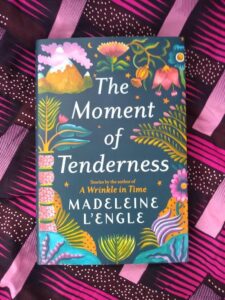
It’s a gamble, a collection of previously unpublished short stories discovered after an author’s death, particularly if, as with The Moment of Tenderness, by Madeleine L’Engle, most of these works were written during her wilderness years, after she’d achieved only modest commercial success with her novels and hadn’t yet published A Wrinkle in Time. Even worse, I read her first novel The Small Rain last year, and I thought it was pretty awful.
So what was I getting into with this new book, in hardcover no less, bewitched by the gorgeous cover design, and its prominent display in a local bookshop window?
Mercifully, it all turned out fine. And that nearly all these stories are worlds away from A Wrinkle in Time actually suits me, as I’m much more a fan of L’Engle’s realism anyway. Many of these stories autobiographical and laid out as a coming-of-age, with child protagonists at the beginning, growing older as the stories progress. Many of these feature a character called Madeleine, even married to a man called Hugh Franklin, as L’Engle was, though Madeleine L’Engle’s husband was on All My Children, and the Hugh Franklin in the book runs a general store. (And as always, it is this way that L’Engle blurs fiction and reality that I find as fascinating as any questions posed by sci-fi or fantasy.)
The middle stories were my favourite, New England fiction that channelled Shirley Jackson, who was L’Engle’s near contemporary. One of the stories even features witches. Others recall the works of John Cheever, stories of suburban dissatisfaction. And there’s even a turn to the Southern Gothic–L’Engle had a transient childhood, but roots in the south.
I loved reading this book, though I am not sure it’s necessarily going to appeal to anybody who ever had a thing for Meg Murry. For L’Engle completists however, and also short story fans, there is so much to delight in.
September 11, 2019
An Acceptable Time, by Madeleine L’Engle

When one day I’m asked the inevitable question: “What was the best thing that you did in 2019, Kerry?”, the answer is going to be: I resolved to read a whole pile of books by Madeleine L’Engle. I owe so much to whomever designed the nice looking recentish paperback editions of L’Engle’s Austin series, and to the librarian who decided to purchase them for the library where I was searching out middle grade titles for my daughter. And there they were—Meet the Austins, The Moon By Night, and The Young Unicorns. I’d dabbled in L’Engle’s Austin series years ago, although her Wrinkle in Time series was more foremost in my mind and I still even have the first three novels in my collection. Without those spiffy library paperbacks, I probably wouldn’t have partaken, but they were good looking, so I signed out all three, and imagined that Harriet and I would read them together.
I passed on to her Meet the Austins, but then I read the next book in the series and decided that Harriet probably wouldn’t appreciate the rest. When she’s a little bit older, and a bit less prone to being spooked about the possibility of nuclear annihilation. It turned out these were novels for me after all, and I loved them. As L’Engle’s A Swiftly Titling Planet has long done (I read that book eighteen years ago today) they brought me strength and solace. It was a long, hard winter and I remember reading The Young Unicorns with head lice, and the books made me feel so much better. I read all the Austins, and then began the Polly O’Keefe books, and read A Severed Wasp because Suzy Austin features—and read A Small Rain too, because it’s about the protagonist of A Severed Wasp. And then finally the last book I had to read was An Acceptable Time, which is about Polly O’Keefe, but which is not technically a “Polly O’Keefe” book, because it’s set in L’Engle’s “kairos” time and is the fifth book in the Wrinkle in Time series. Which I was less compelled by, because it was the realism of the Austin series that drew me more than the sci-fi fantasy elements of Wrinkle. (I am really boring. I am the type of reader who only likes the parts of the Harry Potter books where he’s with the Dursleys.)
But because I am nothing if not a completist (and because I was feeling out of sorts on the weekend, and reading Madeleine L’Engle is a wonderful way to deal with that), I finally tackled An Acceptable Time. Which takes place the year after A House Like a Lotus, and Polly has moved to live with her grandparents at the property we all know from Wrinkle. And guess who she finds outside in the bushes, but actual Zachary Grey, the most unappealing character in all of literature, who never seems to have anything better to do than traverse the globe in pursuit of women who are too young/good for him and them place them in perilous situations.
At first, I thought maybe this time would be different. After all, this book was written 25 years after Zachary Grey first turned up—maybe he’d finally learned to know better. He seems less rude and more interesting at the beginning of the book for sure, and is interested in the ancient civilization whose artifacts are appearing on Polly’s grandparents’ property. Maybe Zachary’s trajectory would be different this time? But this was not to be.
There is a whole storyline when Polly and Zachary become trapped in a tesseract and are taken 3000 years into the past, and everyone wore animal skin tunics and to be honest I just didn’t care in the slightest and skimmed this part. Although I loved this idea that Polly grandparents had built their pool on top of an underground spring that was an ancient holy place, where a lake had been before, and the waters are a portal (and Polly is good at swimming, having been raised on islands, because her father is a marine biologist). Anyway, Zachary wants to go into the past because he has this idea that it will heal his ailing heart, and then it turns out that Polly’s going to be made a blood sacrifice (naturally) and this doesn’t bother Zach in the slightest. He eventually has Polly kidnapped, put in danger, and when she gives him a hard time about this, he storms off: “Polly, I wanted to talk to you, but I can see there’s not point when you’re being unreasonable.” I was all for L’Engle being willing to kill Zachary off, but tragically this does not happen….
Anyway, now that I’ve finished reading these books, I really want to read L’Engle’s Crosswicks Journals, and possibly reread her Camilla, which I loved when I was younger, and then her later book about the same character, published in 1990s, which is not meant to be good, but I think having come to a wider understanding of L’Engle’s work, I might just find it interesting.
July 18, 2019
A House Like A Lotus, by Madeleine L’Engle
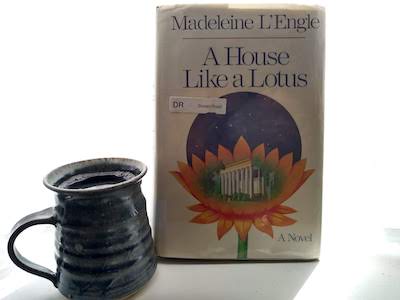
Now here’s a shining lesson on why you should probably write down your thoughts about things and not rely on your brain to remember, because I read the next book in Madeleine L’Engle’s Polly O’Keefe series the week before our vacation, and now I can no longer recall my salient thoughts about the novel, which has since been returned to the library. Though I cannot wholly blame this predicament on my poor brain, because part of the problem is that this novel is blending together with the Austin series into a kind of primordial L’Engle soup. Precocious heroine who is misunderstood and feels she fails to measure up in comparison to her siblings (and, in this case, her impressive cousin Kate); air travel to a foreign destination (Greece!); and she even runs to Zachary Grey (ugh) though it is to Polly’s credit that she’s far less taken with him than Vicky Austin had been.
Partly because Polly has other things on her mind—she is flying to Greece because of an opportunity arrived at by arrangement of her mentor, an older woman who has betrayed Polly in a serious way. What exactly Max has done to Polly is not made entirely clear in the text (Mari Ness, whose reviews of these books I’ve so appreciated as I’ve read them myself, suggests that Max, a lesbian, has made sexual advances to Polly, but I thought the situation was more than Max was ragingly drunk and turned into a bit of a monster, which was really upsetting for Polly to see—she’s only sixteen—because Max was someone she really admired and respected) and the novel moves between Polly’s present situation en-route to and in Greece, and then to her reflections on her relationship with Max, the way it unfolded and fell apart.
Zachary Grey was useful in this book for once (although it true Zachary Grey style, he takes Polly on a reckless adventure and then nearly kills her due to his selfishness and impetuosity) because Polly realizes the way in which she permits this (supposedly) charismatic and exciting young man in her life to be complicated and problematic, but does not offer the same latitude in her considerations of Max and others.
It was also illuminating to read a bit more about Meg Murry O’Keefe, firmly ensconced in her domestic role, who explains at one point that she has arranged her life as such because she felt neglected as a child by her own mother’s career focus and wanted her children to have a different experience. (And now I’m imagining a terrific story underlying this, though I expect it was not L’Engle’s intent, but imagine if you’d had the adventures Meg Murry had in the Wrinkle in Time series? How would you raise your children understanding that the universe is so expansive, strange and dangerous, and that one of your precious babies might tesser into another dimension at any time??? Could that turn you unto something of a helicopter mom? [Although Polly’s parents certainly do permit free rein, as demonstrated by the adventures Polly has got up to so far in the series…] Also, once you’ve been to the limits of space and time, might you consider a career on earth overrated? Would Meg Murry not find all these considerations, actually, a little boring?)
Anyway, I liked this book, though it did not rock my socks and I kind of skimmed the parts once Polly arrives at the retreat where she’s been assigned to make beds for days and days. One more Polly book before me—An Acceptable Time, which I had as a child but never finished—so this whole thing is kind of full circle.
May 30, 2019
The Severed Wasp, and New York City
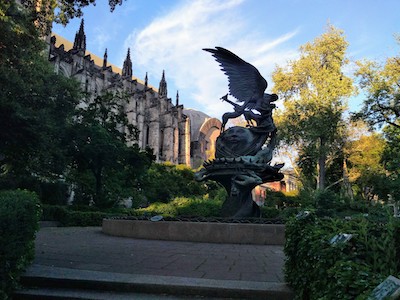
Sometimes, one’s inflexibilities rub up against each other in complicated ways, for example: yes, one wants to read Madeleine L’Engle’s lesser known novels in chronological order (ie two more Polly O’Keefe books to go before I read The Small Rain/A Severed Wasp) but also: I really want to read A Severed Wasp during the weekend we’re in New York, because of its setting (which is the same setting for The Young Unicorns, a novel I adored). So what to do? Well. because I am all cool and laidback, I just skipped ahead to be the other books, NBD. Ha ha.
So first to The Small Rain, which was Madeleine L’Engle’s first novel, published in 1945, 37 years and 29 books before its sequel, almost 20 years before L’Engle made her great success with A Wrinkle in Time. And…it was not good. There were interesting tastes of what would come to be L’Engle’s literary preoccupations—it begins with a young girl being cared for by a friend of the family, because her musician parents are unable to be there for her, which reminded me of Maggy in Meet the Austins. There is romance, there is melodrama, there are weird dynamics between teenage girls and grown men, there is a sea voyage. There are weird problems with plot and pacing, and I didn’t really like the book–it read like something terribly old fashioned written by someone who was terribly young and trying to be terribly edgy, and the effect was kind of terrible. I am glad I read it, but I desperately hoped that A Severed Wasp would be very different, but then I supposed it would be, written 37 years and 29 books later. Possibly, L’Engle has learned something about writing novels in the meantime.
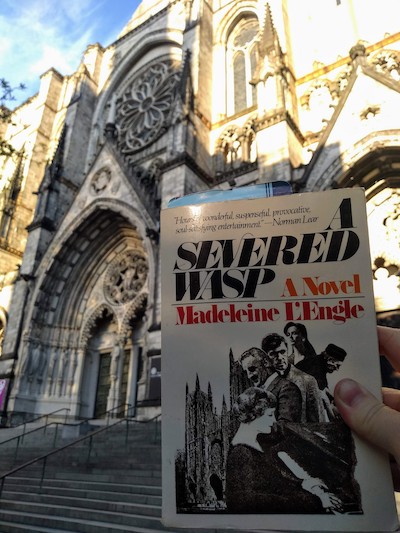
A Severed Wasp—published in 1982, and blurbed by no less than Norman Lear!—finds Katherine Forrester in her seventies now, instead of a teenage ingenue. Now widowed and retired after a hugely successful career as a pianist, she has returned to the scene of the previous novel, to New York where she came of age and suffered her first heartbreaks, and she runs into her old friend from Greenwich Village, Felix, who was once a violin-playing beatnik, but now he’s a bishop, which is the way things go in Madeleine L’Engle novels, at the Cathedral of St. John the Divine on New York’s Upper West Side.
Which is a cathedral I first encountered through L’Engle’s The Young Unicorns (1968), the one book in the Austin series that did not feature Vicky at its centre and which was odd, plot-driven, and very compelling. Dave Davidson, who was a teenage boy in the first book, appears again in this one, now grown and Dean of the cathedral, and married to ACTUAL Suzy Austin, who has realized her dream of becoming a doctor, and is also now a mother of four. Interesting because Suzy had been the one who’d always challenged her own mother’s anti-feminism, and I’d wondered about L’Engle’s emphasis on women who had abandoned dreams of career for families, as though the two were impossible to balance. But here was Suzy, doing it all, which Katherine thinks about a lot, because she is conscious of having failed her own children as she’d travelled and toured for much of her daughter’s childhood, and her daughter now remained quite distant from her—in terms of geography and emotion.
But then we will learn that Katherine’s relationship with her daughter is complicated not just for this reason, but also because the daughter was conceived not with Katherine’s husband who’d been castrated at Auschwitz, but by her Nazi prison guard, with whom she’d had a brief affair right after the war. I know, right? The Katherine of The Small Rain has not lost her taste for melodrama, but the stakes have been raised much higher, plus Katherine is receiving obscene phone calls, Felix is also receiving threats to reveal his homosexual affairs, her pregnant downstairs neighbour’s husband has having an affair with a man, the Bishop’s wife is a former pop-singer whose past involvement with drugs continues to haunt her, the streets of New York are dangerous and riddled with crime, and Suzy Austin’s youngest daughter had lost her leg not long ago after being hit by a car in what may or may not have been an accident.
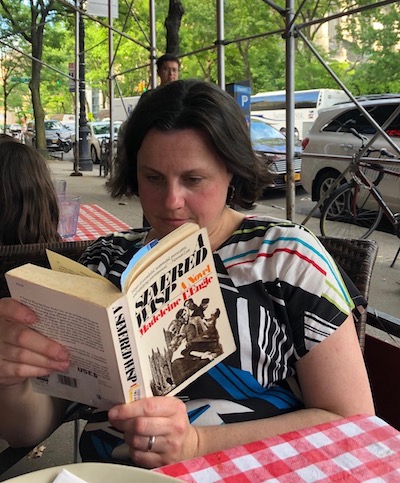
Too much, all of it. Also, too many racist stereotypes—the worst. But the plot did unfold in a most compelling way, and actually being in New York as I was reading made the whole thing much more meaningful to me. (I don’t think many people make A Severed Wasp pilgrimages. There wasn’t even a copy of the book in the Toronto Library system. I had to order a secondhand copy. My instagram hashtag was the only one!) We went to the Cathedral on Friday evening (“The very size of the Cathedral was a surprise…” the book begins. It was!) and got there too late to be able to visit or even explore the grounds, but I just wanted to see it anyway. (Would have been interested to see the plaque that is apparently there once the Cathedral was made a literary landmark because of L’Engle in 2012—she was a writer in residence and librarian there for decades.) We did get to the see the albino peacock in the garden, although the peacocks in the novel seemed to have been conventionally coloured.
We had dinner across the road from the cathedral, and then it was very exciting to be reading the next day and realize that the very place we’d eaten at—the V&T—was described by Suzy Austin was “the best pizza in New York.” It really was! And then the next day we visited other parts of the city, and though I never got to Tenth Street, where Katherine lives in Greenwich Village, we were just close enough that I felt her presence and the streets she’s describing. And the book was in my bag the entire weekend, to be taken out and read on long subway journeys—not that Katherine ever took the subway. I don’t think she even knows it exists.
“Odd, how complex and intertwined life is. Every time I think I’m settling for chance and randomness, then pattern enmeshes me in its strands.”
May 16, 2019
The Arm of the Starfish and Dragons in the Water
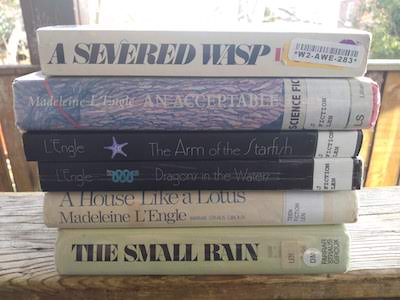
I think it’s been about ten minutes since I last wrote an ecstatic blog post about how my decision to read Madeleine L’Engle’s Austins series was completely the best thing I’ve done in 2019; so we’re due, right? I finished up the Austin books with Troubling a Star about a month ago, and then decided to embark upon the Polly O’Keefe books, which sort of bridge the Austin and Wrinkle in Time Series. I’d tried to read An Acceptable Time as part of the Wrinkle series when I was a child, but I don’t think I finished it, and I can understand now why it might not have appealed to me, because maybe all these books are best understood in the wider context of L’Engle’s fictional universe(s).
Which is the most amazing mind-bending, time-bending universe. When I picked up Arm of the Starfish, I was actually travelling back in time myself from 1994 (when Troubling a Star was published) to 1964, when she published Arm… (I still can’t believe that this book, which includes a grown-up Meg Murry, now a rather innocuous “Mrs. O’Keefe, was written before A Swiftly Tilting Planet. The way that L’Engle wrote her books so far from the chronological order in which they can be understood to be connected to each other…) Which means that while it was remarkable to reading a novel set just before the summer depicted in A Ring of Endless Night, I was also reading a book by a less sophisticated and practiced novelist. The Arm of the Starfish was also the novel with which L’Engle followed up the smash hit A Wrinkle in Time, which no doubt was some kind of pressure.
The book was okay—it was plot driven and interesting and had all the same kinds of thematic concerns of L’Engle’s work (the nature of good and evil and how they’re connected), but it was lacking in depth and was a bit too action packed. I also found Adam Eddington a less compelling narrator than Vicky Austin, and indeed Meg Murry has not grown into a very interesting woman and my goodness, she is has more children than the Old Woman Who Lived in a Shoe. But also, we’re seeing her through Adam Eddington’s eyes and teenage boys are perhaps not the greatest at seeing the marvellousness of a middle aged woman, especially when she is dripping with children. Interesting how Poly swimming with dolphins portends what happens with Vicky Austin not long after—and also I enjoy contemplating what might happen if Poly and Vicky ever met—would the universe explode?
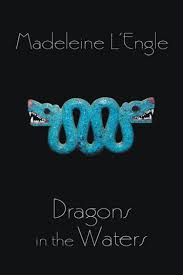
So I wasn’t especially geared up for Dragons in the Water, published in 1976, about a boy called Simon who is on a nautical voyage to Venezuela and meets Poly (who has not yet become “Polly”) and Charles (who is Charles Wallace redux) on board, and together they have to solve a murder and also there are smugglers and art thieves. But I loved it! Simon was a great character (but then again, name a fictional orphan who isn’t) who has been raised to revere an ancestor whose story turns out to be more complicated and troubling than Simon knew. We also get a glimpse of “Mrs. O’Keefe” near the beginning of this book, and she’s a more interesting character than in the previous book.
It was also exciting to meet Mr. Theo who is travelling to hear a concert by Emily, and I met both of these characters first in The Young Unicorns (published in 1969), along with Canon Tallis, who was also in Arm of the Starfish. I love that if we tried to map out a timeline of all these books and universes and how it all fits together, my brain would turn into silly string.
As with the Austin series, the novel is informed by the time it was written in: “I know a lot of politicians nowadays, and even presidents, don’t take promises seriously and even lie under oath, but I was brought up to speak the truth,” says Simon, post-Watergate. I also read this book right after reading an article in The Guardian on a small town in Louisiana that’s one of the most toxic places to live in America because of contamination from a chemical plant, and this scenario is the same as in the novel, which is why Dr. O’Keefe has been called to Venezuela because fish are dying in a lake there where companies are drilling for oil. “Miss Leonis looked down at her feet where black sludge oozed heavily out of the lake. ‘It looks to me as though the oil industry is raping the lake….'”
And then the response: “One thing I have learned in three years at Port of Dragons is that there are no easy solutions.”
And isn’t that the truth.
April 18, 2019
Troubling a Star, by Madeleine L’Engle
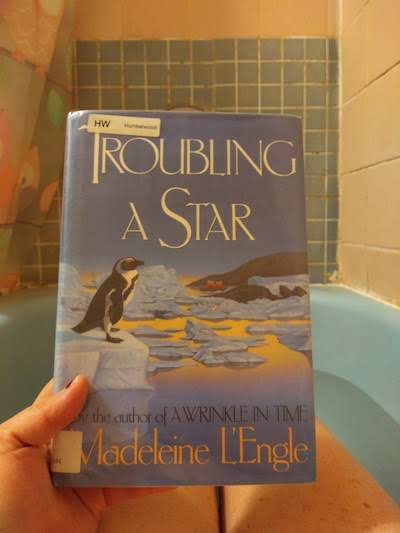
There are only two copies of Madeleine L’Engle’s Troubling a Star in the entire Toronto Public Library system, which made me wonder. The final book in the Austin series, published in 1994 which was 34 years after the series after the series debuted. It begins with Vicky Austin stranded on an iceberg in Antarctica…my hopes weren’t high. And so it was shocking that this was the book of all of them in the series that grabbed me and held me plot-wise, and that I loved it just as much as the other four.
Because while the idea of someone trapped on an iceberg didn’t intrigue me so much narrative-wise, I was all over a plot-driven novel of intrigued concerned with the fictional South American country of Vespugia. Vespugia? I’d not encountered Vespugia within the pages of a book since A Swiftly Tilting Planet, which is my favourite L’Engle novel and the one I’ve read over and over again. In that book, the country is on the brink of nuclear war, and Charles Wallace Murry is called upon to change the past in order to divert it with the help of a unicorn—which he does. By Troubling a Star, however, the country’s benevolent leader has been overthrown and replaced by a dictator, which has changed everything, and suddenly the country is unsafe, police and soldiers everywhere carrying big guns. Like all the books in the series, current events are the backdrop to the story—in 1994 with the fall of the USSR, L’Engle is aware of the precariousness of the new world order (possibly more than many others were at the time) and it makes sense that someone with her understanding of the universe would be able to see the dangers of the vacuum the emerges at the end of the Cold War (“Darkness was, and darkness was good. As was light. Light and darkness dancing together, born together, born of each other, neither preceding, neither following, both fully being in joyful rhythm,” from …Planet).
The story begins with Vicky becoming acquainted with her friend Adam Eddington’s great-Aunt Serena who, with grace and wisdom, fills a void in her life after the recent death of her beloved Grandfather. The family are back in their rural home after their year in New York and the summer of A Ring of Endless Light, and it’s an in-between year for Vicky, who is finishing her final year of high school and is still unsure of her plans for the future. So when Aunt Serena bestows upon Vicky the opportunity to join Adam (a student of marine biology) in Antarctica, she is wild about the idea. Except then she starts getting threatening notes in her locker warning her against the journey, which is very strange, and part of the reason she elects to ignore them.
But things get stranger fast, particularly when she arrives in Vespugia (because the journey to Antarctica is never direct) and begins to suspect that someone has gone through her suitcase, and Adam’s letters from the research station suddenly become cryptic and weird. Everybody travelling with her group begins to look suspicious, and Vicky is no longer sure if there is anyone to trust. Further, chapter begins with a few paragraphs of Vicky stranded on the ice berg, which is great because a) it means not having to read whole chapters about someone stranded on an ice berg and and b) that things for Vicky go so desperately wrong ups the tension and made me want to keep reading to find out how it happened.
A terrible revelation as I was reading this book: it’s uncanny, I’ve said with every one, how each of these novels so imbued with ominous tones of the late 20th century feels so timely now. But maybe it’s less uncanny than just really awful, that nuclear threats, authoritarianism, the omnipresence of dogma, violence and unrest, and chance of mass annihilations all feel so much of this moment: what a time to be alive. Environmental destruction is at the forefront at this book, the hole in the Ozone layer and everything. It anticipates global warming and how important the polar regions are and what bearing they will have on our climate future. And also the brutality and cruelties of nature, and that human beings are very much a part of that. “People who lived, on the surface, ordinary, decent lives also, without any sense of evil, fed other human beings into gas chambers.” In Vespugia, they come across ancient pyramids built by civilizations that were destroyed by colonization. Everything is connected, and nothing about the project of humanity can afford to be taken for granted.
I will admit that I didn’t completely pay attention to the details of the plot here, and some of it’s more than a bit absurd—but not as absurd as The Young Unicorns, which was thoroughly bonkers, so there’s the new standard. I think it’s amazing that this series, which is set in an approximately four year period, was written over 34 years, and manages to encompass massive global events and changes during that time. I know this is supposed to be L’Engle’s series that is doing more conventional things with time (as opposed to Wrinkle…) but it still blows my mind. Plus the ways that this series does (and also doesn’t) map onto the Time Quintet is mind-boggling. Is it the same universe? Are there infinite universes? And what does it mean that we ask these questions about a book that is fiction?
I am going to read The Arm of the Starfish next (which takes place just before A Ring of Endless Light) and then the books in the Polly O’Keefe series, which feature many of the characters I’ve encountered already in the Austin book—and I’m excited about that. The final book in that series is An Acceptable Time, which was published in 1989, which I tried to read years ago with the Wrinkle in Times series, but I see how I might not have appreciated it then. Perhaps I was always meant to wait until I was 40 and had done all the appropriate background reading first.
March 13, 2019
A Ring of Endless Light, by Madeleine L’Engle

“Why all of this, my Lord and my God? Either bring the world to an end or remedy these evils! No heart can support this any longer.” Vicky Austin is reading to her beloved Grandfather, who is dying of leukaemia, and is startled when he bursts out with this utterance. And he explains, “Teresa of Avila said that, in the sixteenth century. It should comfort me that there have always been outrages to the Divine Majesty. But it doesn’t.” He points to the headline in a nearby newspaper: “The headline was a plane crash, a big one, with everybody killed.” What is particularly outrageous about the story is that after the people were killed, others had ransacked the wreckage and the bodies for money and valuables—but this is not my point here. Instead I want to talk about the uncanny way that Madeleine L’Engle’s Austin books have been speaking to the moment I’ve been reading them, even decades after they were written.
Because a big plane crash that killed everybody on board was also top of the news yesterday, 18 Canadians among those who perished on the Ethiopian Airlines flight that crashed on Sunday. And Vicky Austin talks to her grandfather about how she’s been avoiding the news that summer—it’s been a heady time with her grandfather’s illness and the death of a family friend. And Vicky considers, “But not reading the paper only kept me from not knowing things; it didn’t keep them from happening.”
Grandfather, anticipating Twitter in 1980 (when the book was published), says to Vicky, “Maybe instant information isn’t good for us. We can’t absorb it.” Oh, Grandfather. You have no idea.
These books relationship to time continues to fascinate me, seemingly linear and more straightforward than the Wrinkle In Time series. And yet there is more going on than is immediately apparent—first of all, Vicky Austin’s father and another character in this book have all been involved with the research of Dr. Calvin O’Keefe, who is Meg’s companion (and eventually husband) in the Wrinkle series. Which is to say that they inhabit the same universe. But time also unfolds at a different pace than the Wrinkle books do. This book is also written more than a decade after The Young Unicorns, and yet set just a handful of months later. And finally, there is the incredible sense I have that I’m meant to be reading this books right here in 2019, and the reading experiences I’m having are so visceral. I made a chicken dish the other night that was the same dinner I made when I was reading The Young Unicorns, and I was full of Young Unicorns nostalgia. I’d only read it two weeks before, but still. I’ve found all these books so utterly absorbing.
This one is set the summer following the big road trip in The Moon By Night, after the year in New York that was depicted in Unicorns. The Austins have returned to Grandfather’s island to be with him at the end of his life, but focus is shifted when the family’s good friend dies of a heart attack during a sea rescue. The sea rescue turns out to be for Zachary Gray, who was attempting suicide after the death of his mother (who was cryogenically frozen!). And yes, Zach’s back, and as obnoxious as ever, but Vicky is a year older and able to call out his bullshit in a way she wasn’t strong enough to do before. Meanwhile, she’s found out that she has dolphin ESP and is participating in experiments with Adam Eddington at the marine biology station—not that he ever offers to compensate her for her labour, of course, though the station is a pretty bare bones operation.
Which brings me to gender and the Austins, which has shifted a bit since 1968 when the previous novel was published. I’m not saying that Mother wears pants now (because as we learned in The Moon By Night, Daddy doesn’t like women in pants). But none of her children call her “nothing” in this book for her absence of a profession, and she even contemplates doing something with her life when the time comes that the children are grown and gone. She also mentions “inverse sexism” twice, which is kind of terrible. Advising her daughter Suzy that it would only be “inverse sexism” that cheated her out of her understanding her deserved place in the definition of “mankind,” and also calling it when it’s implied that her choice to leave her musical career for marriage was somehow unprogressive. But that sexism is mentioned at all is a kind of progress, I suppose. Vicky is also much less passive in her relations with the young men who are courting her (three of them!). It’s really clear though in reading these books that Madeleine L’Engle was a decidedly unfeminist writer, never mind Meg Murry’s fierce intelligence and strength of will (and remember that Meg in subsequent books becomes just “Mrs. O’Keefe,” wife of the brilliant biologist).
(It is worth noting that Suzy Austin remains unconvinced about her mother’s explanation for “mankind.” I like that L’Engle leaves the space, the possibility, the question there.)
I would like to know more about L’Engle in relation to feminism, and I wondered if she considered it a dogma worth resisting. All the books in the series so far have been about resisting dogma in the context of religion, even as the books themselves are so religious and concerned with issues of morality and mortality. The underlying message in each book seems to be about the danger of thinking we understand everything, about God and the universe in particular. (A thing Meg Murry’s mother once told her is, “But you see, Meg, just because we don’t understand doesn’t mean the explanation doesn’t exist.”) Vicky recalls her grandfather telling her, “As St. Augustine says: If you think you understand it, it isn’t God.” Not knowing seems to be fundamental to understanding, which to a religious person is the definition of faith, but this idea is applicable for those of us who don’t have a religion too (or those of us who are trying to figure out feminism). Just as darkness goes with light, life with death, all of it bound together, this miraculous world and universe.
February 19, 2019
The Young Unicorns, by Madeleine L’Engle
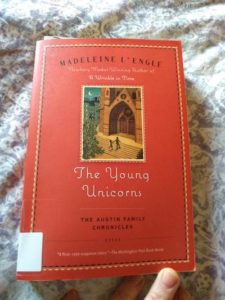
My Madeleine L’Engle/Austins project continued this weekend when I read The Young Unicorns, the third book in the Austins series. A series that is all-over-the-place in the most interesting way, in terms of genre in particular. Because this book (whose narrative does not, in fact, include a single unicorn, in case you were curious) is a dark and plot-driven mystery, very different from the previous two novels which were episodic. It’s also narrated in the third-person and comprises points of view from the entire Austin family. And I don’t remember if I ever picked this book up when I was a child, but I can understand why the Austin series as a whole confused me. Each book is a very different creature, this one set in a gritty and crime-ridden New York City where gang violence and corruption are endemic, where the Austin family has recently relocated to while Dr. Austin, a country doctor, takes up the opportunity to study surgical lasers at a prestigious research lab.
A surprising detail I learned while reading posts and other articles on this book (this one in particular!) was that not only did L’Engle write her books in set two different systems of time (chronos and kairos), but some of the series themselves were written out of sequence. So that The Arm of the Starfish (which I’ve never read) about Meg Murry’s daughter Polly was published in 1965, before either of the two books that immediately followed A Wrinkle In Time sequentially—which surely posed narrative challenges for their author. As I’ve been reading the Austin books I’ve also found it really illuminating to consider each novel in its own historical context—The Moon By Night (1963) informed by the Cuban Missile Crisis and fears of a nuclear holocaust, and now The Young Unicorns, which was published in 1968 and certainly informed by race riots and social unrest of the late-1960s, which is directly referenced in the text—although in her author’s note, L’Engle explains that her story takes place “not in the present but in that time in the future when many changes only projected today may have become actualities.”
Which is significant, because of how timely so many of historical concerns of The Young Unicorns seem for a reader in 2019, just as the previous book’s did. (When I was young, I thought it would be cool to live through the 1960s. Having now lived through the 1960s redux, I’ve changed my mind.) This novel is asking questions about responding to social unrest, about who to trust, whether we can trust anyone, or if trust itself is a fool’s game. It’s also an exploration of the nature of freedom, in particular to how it pertains to religion. Is obedience freedom? Is disobeying freedom, and when isn’t it? What does it mean to have peace if freedom is undermined to achieve it? (And this is where the title comes in, in reference to a quotation about unicorns that cannot be caught by the hunter but instead “can only be tamed of his own free will.”)
One could say the following of all of L’Engle’s books, but it’s especially relevant here: It’s so weird. Country Doctor Austin has been transformed into a scientist (basically Meg Murry’s dad), and Rob Austin is Charles-Wallace reborn, innocent and purely good, and they even have a reliable hound with uncanny awareness of the presence of evil. The Austins have rented the upper floors of an old mansion on Riverside Drive whose lower levels belong to a scholar and his musical prodigy daughter, Emily, who has been blind since a mysterious attack a few years before. Emily takes piano lessons from the eccentric Dr. Theo, and is helped in her studies and all around by Josiah “Dave” Davidson, a former gang member who was even more formerly than that a chorister at the Cathedral Church of St. John the Divine, which looms large in this novel, its catacombs leading through tunnels to abandoned subway stations and there is even a genie who mysteriously appears when the Austin children rub a lamp in an antique shop.
Dave is Black, and we meet him in the novel’s first sentence, and it’s significant, I think, that nowhere in the novel is his race explicitly stated, but we’re meant to infer it because he’s an “ex-hood” who lives in a Harlem tenement. (Race is stated a few times elsewhere in the book—the Cathedral’s Dean is Puerto Rican, and also an “ex-hood;” also, the two scientists who performed Dr. Austin’s job before him are Chinese and Indian, and a character makes a racist statement about their Asian-ness, at one point, but this character is also literally an arch-villain, so this might be the point.)
That race is otherwise absent from the novel is significant though, especially based on its 1968 publication year and its references to riots, mobs run amok. But this was also the heart of the Civil Rights Movement, and to remove race from the story of rioting and social unrest in northern American cities in 1968 is disingenuous. There is a suggestion too that the rioting and violence is thoughtless and rootless, violence for the sake of violence. But maybe this is what happens when you’re the type of person who doesn’t see colour or write colour, and the definition of progressivism in 1968 for many is that the Austin family regularly had a Black boy sit with them at their table, never mind that his Blackness is never delineated.
While a compelling and gripping read, I also found the novel a bit difficult and disorienting. Part of that is the nature of a book that is all about puzzles, tricks, and mystery, but I’m not sure that was it entirely. There is a dinner party scene where Dr. Austin is discussing his work with the Micro-Ray laser with the visiting Canon Tallis, and then the children leave the table, conversation shifts, and then two pages later, Canon Tallis asks, “Just what is your work, Doctor?” And Dr. Austin replies, “I design and make a small surgical instrument known as the Micro-Ray.” “This is on the principle of the laser?” Canon Tallis asks, and I want to yell at him, “Weren’t you even listening when you were talking about this two pages ago????”
So was it a mistake? But then strange to find a mistake in a brand new edition of the book first published fifty years ago, no? Elsewhere, there is also a reference to the revolutionary work of Dr. Calvin O’Keefe on starfish regeneration, which wonderfully blurs the lines between L’Engle’s series, but then in the previous Austin book, set just six months before, Vicky Austin had referenced A Wrinkle in Time as a literary work as she wishes her family could “tesser” across America just like Meg and Charles Wallace Murry. An inconsistency too or something more interesting than that, and I do love the idea that the Austin’s realism is not quite what it seems.
Calvin O’Keefe’s starfish work is from 1965’s The Arm of the Starfish (ostensibly the sixth book after Wrinkle…), which this reviewer found similar to The Young Unicorns but more problematic and less compelling. And in her review she also lays out the problem of Meg Murry, fierce and brave heroine of A Wrinkle In Time, but one who is forever playing second fiddle to a brilliant male character, whether it be her husband or her brother. I have always loved A Swiftly Tilting Planet, the third book in the series, and I’d always hoped that the reason Meg Murry O’Keefe is sitting in her parents’ kitchen while her husband is out saving the world from nuclear annihilation is because she’s nine-months-pregnant with their first child. But if Starfish is any indication, Meg Murry retired from being a feminist icon as soon as she comes of age: “Always called Mrs. O’Keefe, she is calm, reassuring, intent, focused on mothering her children, a near clone of Mrs. Austin in the Austin books, serene and capable. And all wrong for Meg Murry.”
As with the line, “Daddy doesn’t like women who wear pants,” in The Moon By Night, Mrs. Austin in The Young Unicorns is happy enough to uphold the patriarchal status quo. As her daughter Suzy explains of how Mrs. Austin gave up a fledging music career to become a doctor’s wife, “Well, she’s just Mother. She decided she didn’t want to be something, didn’t she?” And it’s interesting that we see L’Engle seemingly unable to write a woman character who balances her creative passions (whether they be art or science) with marriage and family life, especially since she herself managed to do so. Although one could speculate how successful L’Engle actually felt she was in this balancing seeing as she wrote these idealized self-denying maternal figures over and over again.
“I think the closest we ever come in this naughty world to realizing unity in diversity is around a family table,” Canon Tallis comments after spending time with the Austin family, and questions of family, connection ,and disconnection recur throughout the text. For the first time, the Austin family themselves feel estranged from each other, and there are also questions of how they can possibly imagine themselves as an island of peace and calm in a world so dangerous and broken. In their own small town, it was easier to suppose it, but living in the city it becomes undeniable that all things are connected. “And it’s all about what Grandfather’s always saying, how we can’t love each other if we separate ourselves from anybody, anybody at all, and how anything that happens to anybody in the world really happens to everybody.”
January 31, 2019
On Meeting the Austins
Like many bookish people, A Wrinkle in Time played a big role in my literary foundation, although it was the third book in Madeleine L’Engle’s series, A Swiftly Tilting Planet, that I was really passionate about, and have reread many times since. Because although …Planet is fantastical and concerned with time travel and parallel universes, it is very much of this world, which has always been what I’m interested in most. My favourite parts of A Wrinkle in Time were the scenes set in Meg Murry’s kitchen, the meals her mother cooked on her bunsen burner. Likewise, in …Planet we’re back in that same place as the Murry family (Meg pregnant with her first child) awaits perilous news in global politics, a ruthless dictator with his finger on the nuclear button…and Meg’s brother, Charles-Wallace, travels back through time with a unicorn, to mend the brokenness through history that led to the current crisis, brokenness that has always been rooted in family connections or lack thereof. I love this book, and it has brought me tremendous peace and comfort many times.

I loved Meet the Austins. I found it intelligent and comforting, and I knew that Harriet (age 9.5) would love it too. There is not a plot exactly, instead episodes as the characters move in and out of weeks and days. I loved the way that Vicky understood that her family was a kind of cocoon and the questions she was asking about the world outside it, and her apprehensions were the kind that so many children have (and that I have never entirely been able to abandon). It’s a novel that respects its reader, and I enjoyed reading it so much that for days after I lamented that I did not have those few hours to go through again, when I had sat down with this book and been so thoroughly satisfied.
Meet the Austins was published in 1960. In 1962, L’Engle would publish her most famous work, A Wrinkle In Time, which must have meant that by the following year, when The Moon By Night (the next Austin book) was published, her world was a very different place. The world in general was a different place, however, and The Moon By Night is wholly infused with that ominousness, post-Cuban Missile Crisis and the imminent possibility of a nuclear strike. Also, Vicky Austin is 14, which is never a great age, and the world as she knows it has, in fact, already ended—her family are leaving their small town for a new life in New York City, but first, they’re about to drive across the country, a summer vacation never to be forgotten.
It’s a long journey, and on page 83, Vicky’s sister asks her older brother, ‘Hey, John, couldn’t you just tesser us there?’ and Vicky thinks, “It would have been nice if he could have, like Meg and Charles Wallace Murry, but that as Kipling would say, is another story.” Which is the first place L’Engle’s two universes intersect—I love the idea that Vicky Austin has read A Wrinkle in Time too.
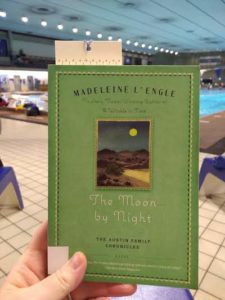
The Moon by Night is remarkable for introducing the most irritating character in all of literature, Zachary Grey, certified beatnik, Holden Caulfield redux, as he’s been kicked out of prep school and calls everyone phoneys. He’s travelling across America with his own parents, who are disinterested and self-absorbed (although you might be too if Zachary Grey was your son). It’s the end of the world as we know it, but Zachary Grey feels fine, and he’s blasé about nuclear annihilation, and patronizes Vicky for her religious leanings. He is an appalling fuckwit, who latches onto Vicky as soon as they meet and calls her Vicky-O, and none of the other Austins can stand him, but Vicky finds him interesting which makes me concerned she’s going to spend her whole life attracted to damaged men who need fixing. He’s also a chauvinist, but who’s not in this novel. When Harriet read Meet the Austins, she was furious about the ways that Vicky is subservient to her brilliant older brother, and the gender dynamics are far more overt in the second book—”Daddy doesn’t like women in pants…” Oh, please. Vicky spends the entire book a passive agent as she’s passed from one jerky boy to the other. Her dad also uses judo kicks to take down a gang of “hoods” attacking their campsite. There’s a prowling bear, deadly floods, and at one point Zachary hides for hours so Vicky will worry come find him, that manipulative bastard, and there is a landslide and they’re trapped for hours, and she doesn’t even let the fact he’s put her life in jeopardy make her consider that she should never ever speak to him ever again.
Does it sound like I didn’t like this book? Not so. Weird ‘sixties slang and other factors aside, I still really loved it. And that I loved it in spite of all the reasons it was terribly annoying is a testament to its value. It’s a novel for a much older reader than Meet the Austins, maybe ideally one who is 39.5 years old and is worried about the state of our world. There is a line in it about Vicky and Zachary’s being the first generation who’s not assured of there being a future, and not the last then, I supposed, and there is some comfort in that, that our world has known peril before. Vicky thinks about her uncle, who was killed in the plane crash in the first book, and the genocide against Native Americans across the country they’re travelling (and it’s remarkable that L’Engle was using the term “genocide” in 1963), and Anne Frank in the Holocaust, and as they travel back east through Canada, she learns about the landslide in Frank, BC, and it haunts her just as much as everything does.
How do you live your life, how can you have faith any, knowing it could all just end at any moment for absolutely no reason? How do you love a world that is home to so much that is just awful? Questions I’m thinking about all the time, so The Moon By Night moved me, decades later. I appreciate too that L’Engle’s religious themes have a universality about them so that the answers apply to those of us who are not Christian, and further that her Christianity is underlined by such largesse, generosity, such grace.
Zachary Grey is one of the characters who appears in subsequent books featuring the Murry/O’Keefes. (Fingers crossed it’s just repeated scenes in which his eyeballs are pecked out by crows.) I want to read them now and see who he is in that other universe, and I look forward to the next Austin book now too, which apparently has its realism shaken a bit with the appearance of aliens. I can’t even… The Young Unicorns is next. I will keep you abreast of my progress.
March 22, 2018
“But you see, Meg, just because we don’t understand doesn’t mean the explanation doesn’t exist.”

I wrote about abortion again. Boring, I know, but every time I write about abortion, it seems to more and more politically imperative to do so. And this piece is one of the best essays I’ve ever written, I think. I’m really proud of it and feel good having those words, this story, out in the world. It’s such a common story, but for so many reasons, it’s not one we read about or hear about very often. Though I’m writing it not just for myself and so many women like me whose uncomplicated, ordinary, straightforward stories of abortion are that it was a good thing, a blessing, and simultaneously not a big deal but also such an important part of our lives. I’m writing it also with the hope of reaching someone who sees abortion as killing a baby, and cannot fathom how it could ever be ordinary, let alone a blessing. Not even to change their mind, but to have them entertain the notion of considering a different point of view. “I understand where you’re coming from,” I want to tell them, because I do, “but for a moment just consider my story.”
Which makes me think of a idea that keeps recurring in Madeleine L’Engle’s A Wrinkle in Time, which I’m reading aloud to my family at the moment. Uttered first in a line by Meg Murry’s mother, who tells her, “But you see, Meg, just because we don’t understand doesn’t mean the explanation doesn’t exist.” Just because someone doesn’t understand my story doesn’t mean my story isn’t true. My story is, no matter how much that complicates your worldview. I’ve written before about being grateful for my abortion, for what it’s taught me about in-betweenness and grey areas, and about the value of listening to people and believing them when they tell you about their experiences. Even if you can’t identify, even if you can’t understand. Because it’s possible that the limits of your understanding are also the limits of your point of view, and I want my ideas to be able to travel further than that. And I hope that other people might see the benefits of such open-mindedness as well.





